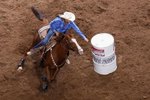
Mounting a horse from the left is a European tradition from the days when gentlemen wore swords. In other times, warriors used either side to board their chargers. In 360 BCE, Xenophon wrote in his "On the Art of Horsemanship" that a rider should be able to mount from either side.
Based on Biology
Mounting from the left may have become the rule because early horse trainers noted that horses demonstrated a preference for being approached and worked from that side, which is now backed up by modern research. Testing reveals that the horse's left eye responds quicker and more strongly to stimuli, and they like to keep humans in that line of sight. To reinforce this, the left side of the horse became known as the "near" side and the right as the "off" side.
From the Right
The cavalry of Alexander the Great, who rode bareback with neither saddle nor stirrup to assist them, used a battle spear to pole vault aboard from the right. Samurai warriors of feudal Japan wore their two swords tucked into the obi or sash, to be handy but out of the way, and are believed to have mounted from the right. Napoleon Bonaparte, who was a left-hander and, therefore, wore his sword on the right, is said to have mounted from the right.
From the Left
In Europe, wearing the sword at the left hip began in Rome, probably about the time Vespasian was emperor, and the practice continued into the Middle Ages as swords became longer and more difficult to manage. Most people then, as now, were right-handed and men hung their swords on their left side, hilt forward for a quick draw. Mounting from the left reduced the rider's chance of entangling himself in his weaponry or stabbing his steed. The tradition was preserved even with the lighter swords of the Renaissance, and continued until the cavalryman and his curved saber were retired from modern combat.
Cowboys and Indians
By the era of the American cowboy in the late 1800s, mounting from the left had become entrenched as the only "proper" or "civilized" way to do it. The Native American, however, being unacquainted with and unencumbered by European anachronisms, mounted from the right, and a horse trained to this became known in cowboy parlance as "Indian-broke."
Ambidexterity
Xenophon was right: there's a lot to be said for mounting a horse from either side. Mounting consistently from the left side puts a lot of pressure on the right side of a horse's withers, which can cause a sore back. It also causes the muscles on either side of his body to develop differently. Training him to accept a rider from either side can help equalize this and make him more balanced. It makes equal sense from the rider's point of view, since situations may arise in which mounting from the left isn't an option: you could be stuck on a trail on a slope so steep that it's not safe to mount from the left for fear of pulling your horse over on you. Even your saddle will benefit from using both sides to mount -- the tree won't warp and the stirrup leathers will stretch equally.
References
- The Generalship of Alexander the Great: J. F. C. Fuller
- Hollins University: On the Art of Horsemanship
- Japanese Weapons.net: The Cult of Japanese Swords
- True West Magazine: Why Do Cowboys Always Mount the Horse from the Left Side?
- Arizona Dude Ranch Association: Let's Ride!
- Successful Horse Training and Care.com: Mounting a Horse (and Leading a Horse) on the Left is Standard Procedure. Ever Wonder Why?
Resources
- Hglanham:Tripod.com: How We Ride: Legacy of the Sword and Mounting Horses from the Left Side
- Oak Creek Horse Ranch: General Horse Riding Safety Tips
- Indiana University: Famous Left-Handers
- Metropolitan Museum of Art: Arms and Armor—Common Misconceptions and Frequently Asked Questions
- College of Veterinary Medicine at Michigan State University: Veterinary Connection: A Mounting Problem
- EquiSearch.com: Trail Rider: Trail Tips: Mount a Horse from Right Side, What to Pack on a Trail Ride
- Central Oregon Trail Horse: Practice Your Off-Side Mount and Dismount
Photo Credits
-
BananaStock/BananaStock/Getty Images




